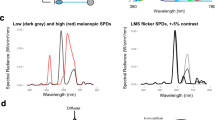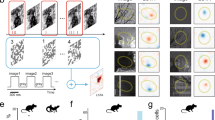Abstract
THE human visual system responds with transient losses of sensitivity when background light levels are suddenly increased or decreased. Crawford1 measured the early threshold changes in humans by means of a small circular test flash presented before, during and after presentation of a larger diameter adapting light. He found that threshold increased just before the onset of the adapting light, reached a peak shortly after onset, and then decreased during the subsequent 0.5 s. Immediately before the offset of the adapting light, threshold increased slightly, peaked at offset and then returned to its original level. Other investigators have reported essentially the same results under various conditions2–4. The increase in visual sensitivity during the first few seconds of light adaptation and the peaked loss of sensitivity at the offset of the adapting light are in the wrong direction as predicted by bleaching of the photopigments. Consequently, Baker5 suggested that neural factors account for the early change in visual adaptation. Unfortunately, the question of mechanisms involved to account for these rapid changes in visual sensitivity cannot be answered from psychophysical experiments since the response range cannot be assessed during these periods.
This is a preview of subscription content, access via your institution
Access options
Subscribe to this journal
Receive 51 print issues and online access
$199.00 per year
only $3.90 per issue
Buy this article
- Purchase on Springer Link
- Instant access to full article PDF
Prices may be subject to local taxes which are calculated during checkout
Similar content being viewed by others
References
Crawford, B. H., Proc. R. Soc., B 132, 283–302 (1947).
Baker, H. D., J. opt. Soc. Am., 39, 172–179 (1948).
Bush, W. R., J. opt. Soc. Am., 45, 1047–1057 (1955).
Boynton, R. M., and Miller, N. D., Illumin. Engineer, 58, 541–550 (1963).
Baker, H. D., J. opt. Soc. Am., 53, 98–103 (1963).
Adams, A. J., dissertation, Indiana Univ. (1970).
Adams, A. J., and Afanador, A. J., Am. J. Optom. Arch. Am. Acad. Optom., 48, 889–894 (1971).
Afanador, A. J., dissertation, Univ. California, Berkeley (1972).
Wagner, H. G., MacNichol, E. F., Wolbarsht, M. L., J. gen. Physiol., 18, 43, 45–62 (1960).
Marks, W. B., J. Physiol., Lond., 178, 14–32 (1965).
Jacobs, G. H., J. opt. Soc. Am., 55, 1535–1540 (1965).
Naka, K. T., and Rushton, W. A. H., J. Physiol., Lond., 194, 259–269 (1968).
Sakmann, B., and Cruetzfeld, O. D., Pflügers Arch., 313, 168–185 (1969).
Werblin, F. S., J. Neurophysiol., 34, 228–241 (1971).
Dowling, J. E., and Ripps, H., J. gen. Physiol., 58, 163–189 (1971).
Werblin, F. S., J. Neurophysiol., 34, 228–241 (1971).
Author information
Authors and Affiliations
Rights and permissions
About this article
Cite this article
AFANADOR, A., ADAMS, A. Early visual adaptation in goldfish retinal ganglion cells. Nature 250, 346–348 (1974). https://doi.org/10.1038/250346a0
Received:
Revised:
Issue Date:
DOI: https://doi.org/10.1038/250346a0
Comments
By submitting a comment you agree to abide by our Terms and Community Guidelines. If you find something abusive or that does not comply with our terms or guidelines please flag it as inappropriate.



